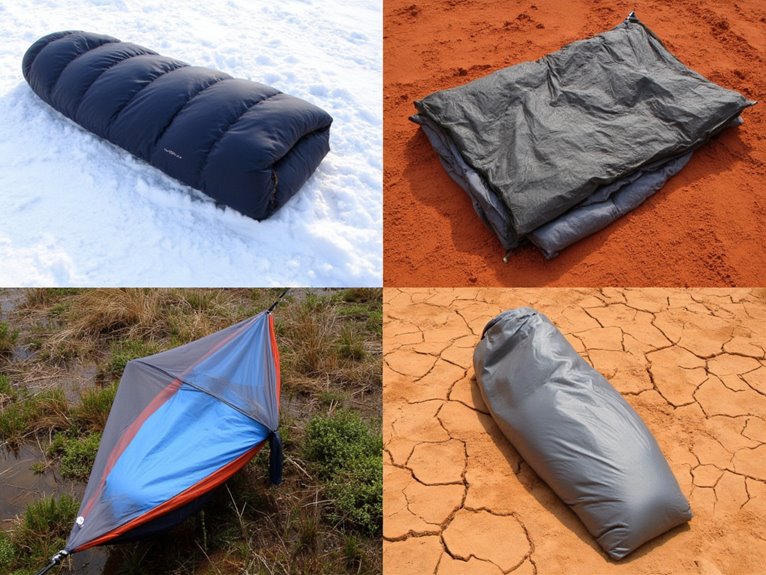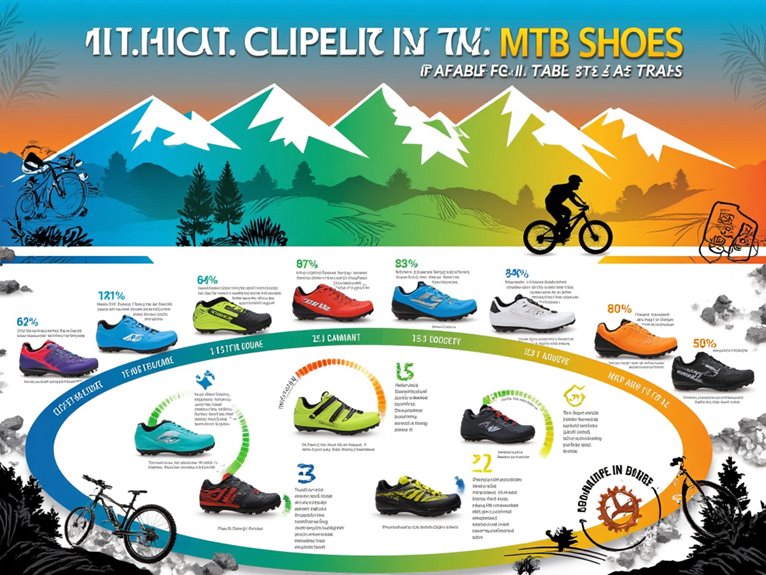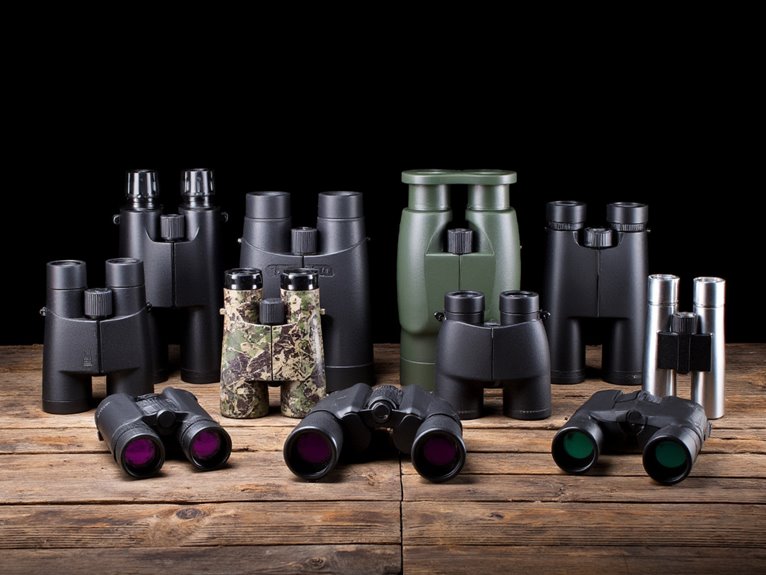How to Build a Climate-Specific Sleep System (Cold, Hot, Humid, Desert)
Building a climate-specific sleep system requires matching your gear to environmental conditions. For cold climates, you’ll need sleeping bags rated 10°F below expected lows, sleeping pads with R-values of 5+, and moisture-wicking base layers. Hot, humid environments demand breathable bedding materials, dehumidifiers, and 65°F room temperatures. Desert climates require adaptable systems for 30-40°F temperature swings using bamboo fibers and evaporative cooling. Modular gear with adjustable layers maximizes versatility while the complete optimization strategy encompasses much more.
We are supported by our audience. When you purchase through links on our site, we may earn an affiliate commission, at no extra cost for you. Learn more. Last update on 10th December 2025 / Images from Amazon Product Advertising API.
Notable Insights
- Cold climates require sleeping bags rated 10°F below expected temperatures, pads with R-values above 5, and moisture-wicking layers.
- Hot and humid environments need dehumidifiers, breathable bedding materials, and air conditioning maintaining 65°F room temperature.
- Desert conditions demand adaptable gear for 30-40°F temperature swings, breathable bamboo/eucalyptus bedding, and evaporative cooling systems.
- Modular equipment like adjustable sleeping bags with zip-off layers and convertible pads accommodate multiple climate conditions efficiently.
- Smart thermostats, adjustable ventilation shelters, and layered clothing systems optimize comfort across varying environmental conditions without redundant gear.
Understanding How Climate Affects Your Sleep Quality
While you might think climate only affects your daytime comfort, it’s actually one of the most significant factors determining your sleep quality. Research shows that climate impact on sleep has intensified over the past five years, with global sleep loss increasing by 5% due to rising nighttime temperatures.
Climate doesn’t just impact your daytime comfort—it’s one of the most critical factors shaping how well you sleep each night.
Higher temperatures directly degrade both sleep duration and quality. Your body requires a core temperature drop of 1-2°F to initiate sleep, but elevated ambient temperatures prevent this natural cooling process.
Desert climates present additional challenges through extreme temperature fluctuations between day and night.
Humidity compounds heat’s negative effects by increasing perceived temperature and blocking natural evaporation.
Vulnerable populations, including older adults and females, experience more severe sleep disruptions. Understanding these climate-specific challenges enables you to build targeted sleep systems.
Essential Components for Cold Climate Sleep Systems
Cold climates demand a fundamentally different approach to sleep systems, where each component must work together to combat heat loss through conduction, convection, and radiation.
Your foundation starts with proper cold ground insulation, requiring sleeping pads with R-values of 5 or higher for winter conditions. Closed-cell foam pads provide consistent performance even when wet, while inflatable insulated pads add vital comfort.
Three essential components form your cold climate sleep system:
- Winter sleeping bags rated 10°F below expected lows, with down insulation for dry conditions or synthetic fill for wet environments.
- Sleeping bag liners that add 5-15°F warmth while managing moisture and maintaining hygiene.
- Moisture-wicking base layers in merino wool or polypropylene, paired with insulating mid-layers and extremity protection.
Layering foam under inflatable pads maximizes insulation for extreme conditions. Women typically require sleeping bags with temperature ratings 10-15 degrees warmer than standard men’s models to maintain comfortable warmth throughout the night.
Optimizing Sleep in Hot and Humid Environments
When temperatures soar above 75°F and humidity climbs past 60%, your sleep system faces the opposite challenge of winter conditions—heat retention becomes your enemy rather than your ally.
You’ll need specialized humidity control to maintain the ideal 30-50% indoor range. High humidity disrupts both slow-wave NREM and REM sleep stages, reducing recovery benefits by interfering with your body’s natural temperature regulation.
Effective cooling techniques become essential.
Install a dehumidifier to control moisture levels. Use breathable bedding materials that wick moisture away from your skin. Position fans strategically to create cross-ventilation airflow patterns. Keep your room temperature at 65°F using air conditioning when possible. Close blinds during daylight hours to block heat gain.
These targeted adjustments will restore your sleep quality despite challenging environmental conditions.
Desert Climate Sleep Strategies for Temperature Extremes
Desert environments present unique thermal challenges that require specialized sleep strategies beyond standard hot-weather approaches.
Desert sleeping requires advanced thermal management techniques that go far beyond typical warm climate solutions.
You’ll face extreme temperature swings between scorching days and surprisingly cool nights, demanding adaptable cooling strategies.
Your desert bedding system needs breathable materials like bamboo or eucalyptus fibers that wick moisture while maintaining durability in arid conditions.
Layer lightweight blankets for temperature flexibility as nighttime temperatures can drop 30-40°F below daytime highs.
Essential desert sleep adaptations include:
- Smart thermostat programming – Set cooling to 67-72°F during peak heat hours, adjusting for nighttime temperature drops
- Evaporative cooling systems – More efficient than standard AC in low-humidity desert conditions
- Hydration timing – Drink water 2-3 hours before bed to prevent dehydration without disrupting sleep
Monitor seasonal variations closely.
Fall through spring offer ideal natural cooling opportunities in desert climates.
For outdoor desert camping, consider closed-cell foam pads that offer maximum durability in harsh sandy conditions and don’t risk punctures from thorns or sharp rocks.
Building Your Adaptable Climate-Specific Sleep Setup
Although many sleep systems target specific climates, building a truly adaptable setup requires modular components that function across multiple environments. Your foundation starts with adjustable sleeping bags featuring zip-off layers or variable temperature ratings. These bags adapt from 15°F to 65°F through removable liners.
Select modular gear like convertible sleeping pads that offer dual-density zones. Dense foam provides cold-weather insulation while softer sections enhance hot-climate breathability. For maximum adaptability, choose pads with 4-5 inch thickness that deliver optimal support across varying terrain and temperature conditions. Temperature control becomes manageable through interchangeable components rather than separate systems.
Your shelter needs adjustable ventilation panels and removable rainflies. Multi-season tents with zippered mesh sections let you customize airflow instantly.
Pack layered clothing systems using moisture-wicking base layers, insulating mid-layers, and weather-resistant outer shells. This modular approach eliminates carrying multiple complete systems while maintaining ideal performance across diverse climates.




